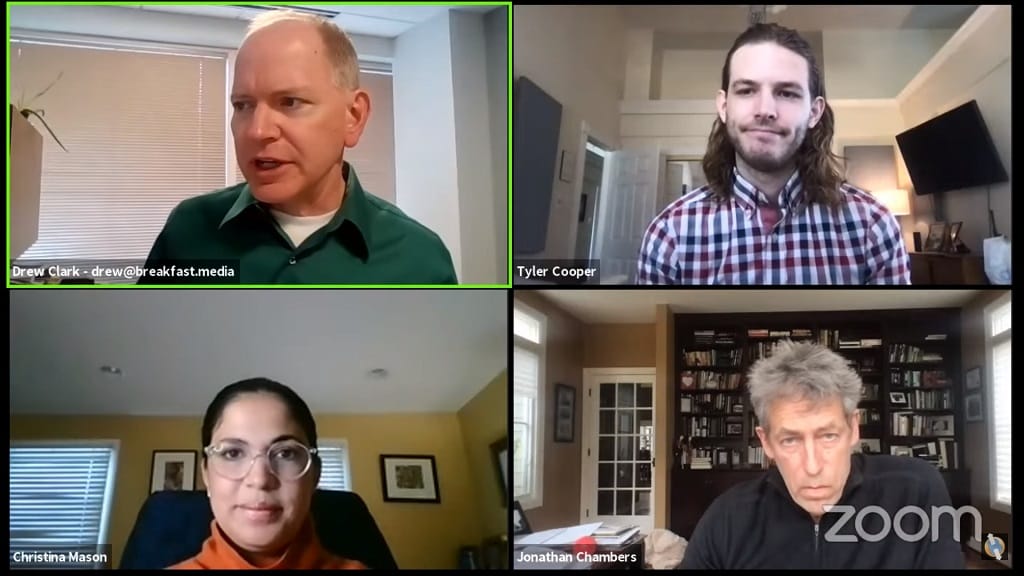Broadband Breakfast Panelists Wrestle With the Speed Definition of High-Speed Broadband
March 18, 2021 – Should the Federal Communications Commission update its definition of high-speed broadband to account for overall faster connections? Industry experts at the Broadband Breakfast Live Wednesday event responded: “It’s complicated.” For BroadbandNow’s Tyler Cooper, the simple answer wa

March 18, 2021 – Should the Federal Communications Commission update its definition of high-speed broadband to account for overall faster connections? Industry experts at the Broadband Breakfast Live Wednesday event responded: “It’s complicated.”
For BroadbandNow’s Tyler Cooper, the simple answer was yes. “It changed in 2010, it changed in 2015, its 2021. Technology is changing, I think the definition should change as well,” he said. But what that change should be is more complicated and depends on different factors, he explained.
When the Telecommunications Act passed in 1996, broadband was defined as a connection speed of at least 200 kilobits per second (Kbps), and it was most recently updated in 2015 to a minimum 25 Megabits per second (Mbps) download and 3 Mbps upload to define a high-speed internet connection.
It’s important to separate how we talk about served and unserved areas, said Christina Mason, vice president of government affairs at the Wireless Internet Service Providers Association.
Different areas require different solutions
“I think the problem that’s happening in Washington, DC, is that we are conflating a lot of different problems, and trying to solve it with one silver bullet solution,” she said. There is a difference between living an area with competitive broadband options and an area with limited service, and those two areas need different solutions, she said.
Some locations may not have access to fiber, for example, or limited competitive options, so the conversation should be tech-neutral to allow all types of broadband providers to open up access to unserved areas, she said.
Someone sitting in an office in Washington, D.C., shouldn’t define what broadband is, said Jonathan Chambers, who formerly worked at the FCC, and is partner at the firm Conexon. The question should be reframed because broadband is determined by what people want and what the public subscribes to, he said.
There are different speed definitions that the FCC uses, Chambers said, and the 25/3 Mbps speed benchmark is used to determine whether an area is served or unserved. Instead, Section 254 of the Telecommunications Act should be used to define served and unserved areas, he said.
Section 254 defines access to “advanced telecommunications and information services,” which includes broadband, as “reasonably comparable” to services and rates already offered in urban areas.

But the term “reasonably” should be dropped from the definition because people have used it as an excuse, Chambers said. “Those over the course of the last 25 years since those words were enacted, people who argue that things should be ‘reasonably comparable’ in rural areas or ‘reasonably comparable’ for low-income consumers, typically laying heavily on the word ‘reasonably’—that is to say, they mean, ‘not comparable,’” he said.
Chambers said that government defines broadband only for funding reasons. “For purposes of government activity, you define broadband so you can determine where funding should be and what that funding goes for,” he said.
Long-term investment in broadband infrastructure
“It’s difficult to paint with a broad brush here, because I think it’s important to balance the conversation around getting people connected today, which is essential, but also serving them well in the long run,” Cooper said. “If we’re spending federal funding to get people connected today, we want to make sure that connection appreciates over time,” he said.
“It’s really important we look at how networks are evolving and how consumer behavior is evolving,” Cooper said. What consumers want and need currently may change down the road, he said. Data shows that consumers are learning that broadband isn’t a luxury anymore, it’s a necessity, he said.
“We should be doing everything in our power, whether that’s a federal definition or some other incentive, to put in place technologies that are going to serve us well in the future,” he said.
Chambers expressed similar sentiment. The government is at a point where spending over $100 billion dollars in broadband infrastructure is on the table, he said. “If you’re going to spend over a $100 billion dollars, don’t cheat the public. Don’t aim low,” he said. Funding for both infrastructure and competitive subscriber-based subsidies in rural and low-income areas are important, he said.
Mason agreed as well, saying that the conversation isn’t just about speed or technology, but also infrastructure and competition.
“Focusing on the speeds, we’re missing the issue,” she said. Competition is important and different technologies need to be allowed to find the solution for unserved areas, she said.
Our Broadband Breakfast Live Online events take place every Wednesday at 12 Noon ET. You can watch the March 17, 2021, event on this page. You can also PARTICIPATE in the current Broadband Breakfast Live Online event. REGISTER HERE.

Wednesday, March 17, 2021, 12 Noon ET — “Redefining Broadband’s Speed Limit”
- When “broadband” was first defined by the Federal Communications Commission in 1996, it measured at least 200 kilobits per second (Kbps) in either direction. In 2010, the agency revised the definition to be at least 4 megabits per second (Mbps) download and 1 Mbps upload. Five years later, the agency upped the standard to 25 Mbps down and 3 Mbps up. That definition is already showing its age. Further, other states and federal agencies have other definitions. Is it time for a new broadband speed limit?
Panelists:
- Jonathan Chambers, Partner, Conexon LLC
- Tyler Cooper, Editor-in-chief, Broadband Now
- Christina Mason, Vice President of Government Affairs, Wireless Internet Service Providers Association
- Drew Clark (moderator), Editor and Publisher, Broadband Breakfast
WATCH HERE, or on YouTube, Twitter and Facebook.

Jonathan Chambers is currently a Partner at Conexon. He has spent the past 25 years working with cable television providers, wireless companies and electric cooperatives in the early stages of planning, designing, constructing and operating telecommunications and internet access networks. Between 2012 and 2016, Mr. Chambers served as the Chief of the Office of Strategic Planning and Policy Analysis for the FCC. He holds a BA in economics from Yale College, an MA in international affairs from Columbia and a JD from Georgetown University Law Center.
Tyler Cooper is Editor-in-chief at BroadbandNow. He has more than a decade of experience in the telecom industry and has been writing about broadband issues such as the digital divide, net neutrality, cybersecurity and internet access since 2015. His work is internationally recognized; he has been published on sites like VentureBeat, TechRadar and The Next Web. He has also been featured in VICE, Digital Trends, Fox News, Voice of America, and many other outlets.
Christina Mason currently serves as Vice President of Government Affairs at Wireless Internet Service Providers Association. She has over a decade of experience in government relations planning and outreach. Before joining WISPA, she worked on the Hill at the office of Congresswoman Yvette D. Clarke and as a lobbyist for The American Institute of Architects. She holds a BA in Communications and English from La Salle University and earned her JD from Howard University School of Law in Washington, DC.
Panelist Resources
- Research, BroadbandNow
- See “Interview with BroadbandNow about Lower Costs and Lower Latency,” Broadband Breakfast, February 25, 2021
- See “Interview with BroadbandNow about Gigabit Coverage and Unreliable FCC Data,” Broadband Breakfast, December 27, 2020
- See “Interview with Tyler Cooper and Jenna Tanberk about Open Data Set from BroadbandNow,” November 20, 2020
As with all Broadband Breakfast Live Online events, the FREE webcasts will take place at 12 Noon ET on Wednesday.
SUBSCRIBE to the Broadband Breakfast YouTube channel. That way, you will be notified when events go live. Watch on YouTube, Twitter and Facebook.
See a complete list of upcoming and past Broadband Breakfast Live Online events.









Member discussion